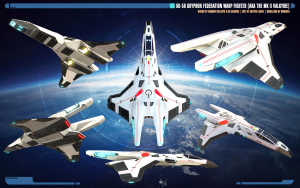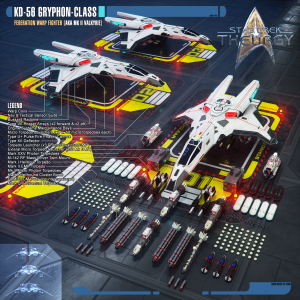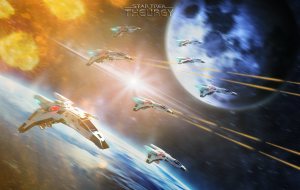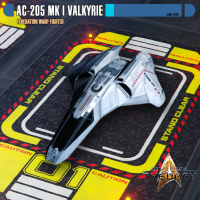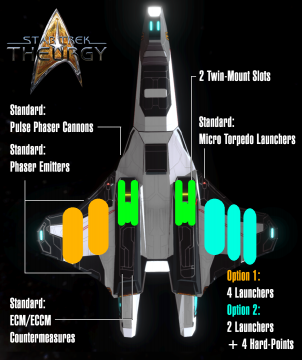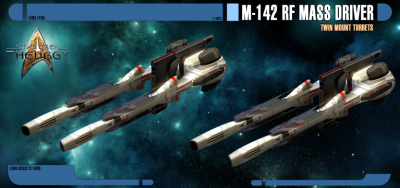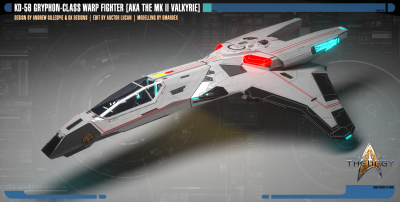AC-307 Mk II Valkyrie: Difference between revisions
From Star Trek: Theurgy Wiki
Auctor Lucan (talk | contribs) No edit summary |
Auctor Lucan (talk | contribs) m (Text replacement - "Starfleet Aerospace Command" to "Starfleet Astronautical Command") |
||
| (92 intermediate revisions by 6 users not shown) | |||
| Line 1: | Line 1: | ||
{| class="wikitable floatright" style="width: 20%; background: #252525; color: white;" | {| class="wikitable floatright" style="width: 20%; background: #252525; color: white;" | ||
| colspan="2" | [[File: | | colspan="2" | [[File:OVERVIEW GRYPHON WARP FIGHTER.png|300px]] | ||
|- | |- | ||
| Name: | | Name: | ||
| | | Gryphon-class<br> (commonly referred to as "Mk II Valkyrie") | ||
|- | |- | ||
| | | Model: | ||
| AC-307 | | AC-307 | ||
|- | |- | ||
| Line 17: | Line 15: | ||
|- | |- | ||
| Purpose: | | Purpose: | ||
| | | | ||
* Carrier Based Attack | |||
* Short Range Strike Craft | |||
* Planetary Defense | |||
* Patrol | |||
* Reconnaissance | |||
|- | |- | ||
| Constructed: | | Constructed: | ||
| Line 34: | Line 37: | ||
|- | |- | ||
| Mass (w. Standard Armament): | | Mass (w. Standard Armament): | ||
| 26 | | 26 100 kg | ||
|- | |- | ||
| colspan="2" | | | colspan="2" | | ||
| Line 40: | Line 43: | ||
| Technical Specifications | | Technical Specifications | ||
| Advantages | | Advantages | ||
* | * Many hard-point options available | ||
* | * Improved avionics and handling compared to the Mk I | ||
* | <br>Disadvantages | ||
* Inferior hull armour & shielding compared to the Mk III | |||
* Challenging whithout a RIOs in the backseat | |||
* Low maximum/standard warp speed | * Low maximum/standard warp speed | ||
|- | |- | ||
| Standard Crew Complement: | | Standard Crew Complement: | ||
| * (x1) | | | ||
* Tactical CONN Pilot (x1) | |||
* Optional: Rear Intercept Officer (x1) | |||
|- | |- | ||
| Warp & Impulse Speeds: | | Warp & Impulse Speeds: | ||
| | | | ||
* Standard Speed: Warp 5. | * Standard Speed: Warp 5.6 | ||
* Maximum Speed: Warp 7. | * Maximum Speed: Warp 7.4 | ||
* Maximum | * Maximum Impulse: 0.75 C | ||
* Combat Speed: | * Combat Speed: 960 Km/s | ||
|- | |- | ||
| Tactical Specs: | | Tactical Specs: | ||
| | | | ||
* (x2) Type | * (x2) Type U+ Pulse Phaser Cannons (forward-facing) | ||
* (x4) Type | * (x4) Sheathed Type VII Phaser Arrays (wing-mounted, 2 forward & 2 aft) | ||
* (x2) Mk II Micro Torpedo Launchers (40-round 30cm Microtorpedoes each) | |||
* (x2) Mk | |||
|- | |- | ||
| Defensive Specs: | | Defensive Specs: | ||
| | | | ||
* | * Duranium/Tritanium Composite Hull | ||
* | * 10.7 cm Type II Ablative Hull Armor (10.7 cm OCP) | ||
* Beta 4/D Class 375 Isoton/s Shields | |||
* Class 2 Structural Integrity Field | |||
* Type XII Deflector | |||
|- | |- | ||
| Engine Specs: | | Engine Specs: | ||
| | | | ||
* | * TPG Class 5/L M/ARA Warp Engine | ||
* | * Gullwing Type 3H Warp Nacelles | ||
* | * Scott-class 4/E Impulse Engine | ||
* | * Pulsed Trentis Mk. IV RCS Thruster Assembly | ||
|- | |- | ||
| Other Systems | | Other Systems | ||
| | | | ||
* | * (x1) 5 Module Isolinear Computer Core | ||
* (x1) Long Range Subspace Antennae | * (x1) Long Range Subspace Antennae | ||
* ( | * (x1) Short Range Subspace Antennae | ||
* (x1) Micro Transporter Cluster | * (x1) Micro Transporter Cluster | ||
* (x1) Short-Range Tractor Beam Emitter | * (x1) Short-Range Tractor Beam Emitter | ||
| Line 92: | Line 95: | ||
| | | | ||
* Advanced Tactical Sensor Suite | * Advanced Tactical Sensor Suite | ||
* | * Class 3/Beta Omni-directional Sensors | ||
* Standard Navigational Sensor Suite | * Standard Navigational Sensor Suite | ||
* High Resolution Sensor Range: 5.2 Ly | * High Resolution Sensor Range: 5.2 Ly | ||
* Low Resolution Sensor Range: 26.2 Ly | * Low Resolution Sensor Range: 26.2 Ly | ||
|- | |- | ||
|Other Standard-issue Equipment<br> (stored in cockpit) | | Other Standard-issue Equipment<br> (stored in cockpit) | ||
| | | | ||
* | * Type III Phaser Assault Rifle | ||
* Extra rations (14 days) | * Extra rations (14 days) | ||
* Power cells (for the | * Power cells (for the Tactical CONN exosuit's hand phaser as well as the rifle stored in the cockpit) | ||
|- | |- | ||
| colspan="2" | [[File: | | ''Design:'' | ||
| | |||
''Andrew Gillespie'' | |||
|- | |||
| ''3D Model:'' | |||
| | |||
''Omardex'' | |||
|- | |||
| colspan="2" | [[File:Valkyrie-Mk-II-Weapons-Display.png|300px]]<br>[[File:Dor'GhItlh-Squardon.png|300px]] | |||
|} | |} | ||
This was the second iteration of the ''Valkyrie''-class [[Warp]] Fighter. The Mk II - commonly called the Gryphon - was designed for attacking stronger opponents. Compared to the Mk I, it included upgrades to the nacelles for faster maximum and emergency [[warp]] ratings, improved pulse phasers, and stronger shields. | |||
The [[AC-205 Mk I Valkyrie|original Valkyrie - the Mk I]] - first appeared as a new [[warp]] fighter aboard an experimental ''Typhon''-class carrier. The Valkyrie was intended to replace the ageing fleet of ''Peregrine''-class fighters currently in use throughout the fleet. Smaller and more agile, ''Valkyrie''-class fighters were used for a variety of missions. Unlike the ''Peregrine''-class, the Valkyrie was intended to be used in small groups, which made it ideal for fighter wing groups. | |||
The Mk II Valkyries were the kind of [[warp]] fighters that were commissioned to the [[USS Resolve|''USS Resolve'']] and the [[USS Harbinger|''USS Harbinger'']], among other ships in [[Starfleet]] during the end of the 24<sup>th</sup> century. | |||
== Fighter Demonstration == | == Fighter Demonstration == | ||
<include iframe src="https://sketchfab.com/models/ | <include iframe src="https://sketchfab.com/models/9c576eca673a453d80c80c88c2622ca5/embed" width="490" height="380" frameborder="0" scrolling="no" allowfullscreen="allowfullscreen" mozallowfullscreen="true" webkitallowfullscreen="true" onmousewheel="" /> | ||
== Production History == | == Production History == | ||
[[File: | The formation of the [[[[Starfleet Astronautical Command]]]] was heavily influenced by the successful deployment of ''Peregrine''-class fighters aboard the starships serving as carriers in the fleet, yet the ''[[USS_Theurgy|USS Theurgy]]'' did not hold a squadron of ''Peregrine''-class fighter aboard, but the more developed ''Valkyrie''-class. Namely, the [[AC-409 Mk III Valkyrie|prototype Mk III version]], a superior fighter that made use of recent advances in technology. | ||
At the success of the Mk II and the fleet-wide deployment of the Valkyries in the fleet, Starfleet Command began looking into the Valkyrie with more interest | |||
[[File:Mk-I-Valkyrie.png|left|200px]]The year 2375 - after the conclusion of the [[Dominion War]] - the [[AC-205 Mk I Valkyrie|AC-205 Mk I Valkyries]] were deployed. These fighters were assigned to the ''USS Typhon'' (TNG game: Star Trek: Invasion). They were initially designed as a carrier-based fleet engagement craft. Initially, the design proved successful, with a high survivability rate matching the heavy fire power available to bring down larger ships. In learning that a full squadron of Valkyries would still require a lot of support from for engagements of a Dominion-War level threat, Starfleet deemed that the attack fighter needed an upgrade. By 2381, these fighters were still being deployed in fairly limited numbers - shuffled around the fleet. | |||
Another development at the time was that a group of influential admirals in the fleet demanded to form a new department that hand-picked the [[Command, Tactical & CONN|Conn]] officers with the most tactical training. It was the only way, they reckoned, to ensure the fleet used the right kind of pilots for these fighters. The original score of 400 personnel - the fleets new Tactical CONN officers - served as the foundation for a new and more organized department for fighter pilots. They accepted only the highest scoring Conn or fight-trained [[Security]] or [[Command, Tactical & CONN|Tactical]] Cadets, and then dealt them another year of training in the fields they lacked from their [[Starfleet Academy|Academy]] training. White became the chosen color for the department, and the admirals that rode this project into history became the core of the Aerospace Command. | |||
Both the [[AC-205 Mk I Valkyrie|Mk I]] and II Valkyries used Rear Intercept Officers (RIOs). The efficiency in which the attack fighters were operated was doubled by allowing the pilots to focus solely on the maneuvers and weapons employment of the craft during a fight, allowing the RIO to handle comm traffic, emergency repairs and tactic simulations. Among the improvements for the Mk II Valkyrie were a new ablative armor compound, improved power plant, and the employment of a hardpoint system beneath the wings. | |||
The Type U+ Pulse Phaser Cannons worked on the same principles as the Type U Pulse Phaser Cannon on the Defiant-class starships, but at a much smaller scale as well as 20% reduced output. The first iteration of the U+ could be seen on either side of the AC-307 Mk II Valkyrie fighter, but a second version was made to be wing-mounted on the [[AC-409 Mk III Valkyrie]]. It was the same technology in both versions of the U+ cannons, only on the [[AC-409 Mk III Valkyrie|Mk III]], the entire weapon system was mounted on the wings instead of being inside the fuselage of the fighter (as it was in the [[AC-307 Mk II Valkyrie|Mk II]]). There were pulse or beam firing options available. Bolts had a firing rate of 5 per second. The beam setting had lower yield but longer range. | |||
With the Mk II, the Valkyrie truly stepped into a class of her own. At the success of the Mk II and the fleet-wide deployment of the Valkyries in the fleet, Starfleet Command began looking into the Valkyrie with more interest. | |||
== [[Tactical]] Systems == | |||
[[File:Gryphon-Loadout.png|right|302px|thumb|''Image: Please see the two options in the bottom right corner.'']]The Mk II Valkyrie had two different hard point configurations, as shown in the image on the right. | |||
Besides the [[Phaser Technology|phasers]], which was a standard technology, other [[warp]] fighter tactical systems can be found below: | |||
==== - Twin Mount Turrets ==== | |||
Twin Dual Cannon guns utilizing an ammunition replicator to create 30 mm Osmiridum shells. These shells were suspended in a small [[warp]] field bubble to render them nearly weightless before being electromagnetically propelled at a speed near mach 15 with a rate of up to 1000 rounds per minute, assuming all four cannons were being fired. Devastating against soft targets as well as being effective against armors of nearly all types, it was however, ineffective against shields, and its projectiles could be easily reflected via standard deflector arrays. The weapon could be placed in a fixed forward position or could be set to automatically track subsonic targets for fire, though it proved to be ineffective at automatically tracking fast moving small targets. It could hit large targets moving at high speeds but not with the same precision as expected with slow or fixed targets. Designed for aerial and suborbital assault on non-shielded Terrestrial targets, deep space strikes against bases, and aerial support of ground [[operations]] ([[AC-307 Mk II Valkyrie#M-142_RF_Mass_Driver_Twin_Mount_Turrets|see below for more information]]). | |||
==== - ECM Pod/ECCM Emitter ==== | |||
Counter measures. These were not options but loaded into the aft of the fuselage as standard. ECM (Electric Counter Measure) was essentially a micro torpedo full of shrapnel and debris with the given craft's transponder signature and sensor reading. It confused the enemy ordinance and caused it to think the cloud of debris was the target. ECCM (Electric Chemical Counter Measure) created a wake similar to a [[warp]], impulse, or thruster engine's wake, fooling such a guided missile into a false lock. | |||
===Launchers=== | |||
There were two kinds of launchers that could be mounted underneath the wings of these fighters, one for standard torpedoes and one for micro-torpedoes. | |||
==== - Torpedo Launchers ==== | |||
Additional, wing-mounted torpedo launchers that can hold 3 photon torpedoes, EMP torpedoes or Quantum Torpedoes in any kind of combination. It was recommended to mount two of these in order to balance the fighter properly. This meant that the hard-point option of additional torpedo launchers held 6 torpedoes when the Valkyrie was deployed into battle. | |||
==== - External Micro Torpedo Launchers ==== | |||
Additional, wing-mounted micro torpedo launchers that can hold either 56 Mk II micro photon torpedoes. It was recommended to mount two of these in order to balance the fighter properly. This meant that the hard-point option of additional micro torpedo launchers held 112 additional micro photon torpedoes in total when the Valkyrie was deployed into battle to complement those that the Valkyrie itself already had as standard internal armament. | |||
== | ===Standard Torpedoes=== | ||
These kinds of torpedoes were loaded into the torpedo launchers. | |||
==== - Mk XXVII Photon Torpedo ==== | |||
Standard photon torpedo ordinance. The explosion was a matter-antimatter reaction producing large amounts of gamma waves as its primary means of destruction. While smaller in size, and harder to target mid-flight, each torpedo had the approximate yield of 70% compared to the Mk IV (the kind that [[Federation]] starships launched from their torpedo bays). This torpedo was deployed in the wing-mounted additional torpedo launchers (see above). | |||
==== - EMP Torpedo ==== | |||
Created the electromagnetic pulse similar to what was created from the high atmosphere detonation of a nuclear warhead. A well-shielded craft would withstand this easily but the weapon would detonate in a burst of broadband, high-intensity electromagnetic energy, capable of disrupting magnetic fields and producing current or voltage surges in conductive materials via magnetic induction. Indirect damage to enemy hardware often proved substantial, and while it had a greater chance of disabling a small craft, the plasma surges could wound or kill soft targets if they were directly exposed. | |||
==== | ==== - Mk Q-II Quantum Torpedo ==== | ||
An improvement of the Mk XXV photon torpedo with a higher yield, comparable to that of photon torpedo mounted on [[Federation]] Starships. This was a tactical quantum weapon, that utilized a plasma warhead and casings similar in shape to photon torpedoes. The explosion left an antimatter residue and although they were powerful weapons, even a direct hit from a quantum torpedo might not destroy neutronium alloyed targets. | |||
==== | ===Hard-Points=== | ||
==== - Mk I Hellbore Torpedo ==== | |||
An experimental weapon that grew out of historic tandem-charge armour-penetrating designs. Attempting to achieve similar function from contemporary photon and quantum warheads was pointless; the detonation of the first would obliterate the second too early, and a submunition method was less effective than simply firing two torpedoes. Advances in material [[science]] led to a way to produce neutronium in small quantities - fashioned into a penetrator cap and coupled to a small subspace field generator, and driven by a single-burn impulse unit whose size belied its power, the nose of the missile could tear its way through alloys with even the strongest of structural integrity field enhancements, allowing the oversized antimatter warhead in the belly of the torpedo to detonate well inside the defensive screens of its target. Due to the projectile's large size and slower speed compared to the smaller conventional torpedoes, the penetrator cap was ineffective against shielded targets and was best deployed against unprotected hulls. However, the yield was heavy enough to cause severe damage to shields nonetheless. | |||
==== Mk | ==== - Mk I Hellhound Cluster Bomb ==== | ||
Similar in nature to the photon torpedo, this was a photon torpedo filled with several micro torpedoes. Once the torpedo came in contact with an enemy or a surface, it detonated and fragmented into smaller torpedoes, which spread from the point of impact, also exploding on impact, resulting in a large pattern of torpedo detonations. Deployed correctly, this hard-point had the potential to cause severe damage when scattered upon enemy shields on impact. The torpedo snapped open by spring-force, and both the arming and the fuse was pilot-controlled by either manual or automatic settings. It could be armed prior to discharge or scattered by manual command. | |||
=== | <gallery mode="packed" heights=50px style="text-align:left"> | ||
File:ECM-pod-details.png | |||
File:TORPEDO LAUNCHER.png | |||
File:torpedo-launcher-details.png | |||
File:photon-torpedo-details.png | |||
File:EMP-torp-details.png | |||
File:quantum-torp-details.png | |||
File:hellborne-details.png | |||
File:hell-hound-details.png | |||
</gallery> | |||
==== | == 3D Demo: <nowiki>Warp</nowiki> Fighter Weapon Systems == | ||
==== | <include iframe src="https://sketchfab.com/3d-models/starfleet-warp-fighter-weapon-systems-1aa1dce6865b414286c02a7267c4b09e/embed" width="490" height="380" frameborder="0" scrolling="no" allowfullscreen="allowfullscreen" mozallowfullscreen="true" webkitallowfullscreen="true" onmousewheel="" /> | ||
== | == M-142 RF Mass Driver Twin Mount Turrets == | ||
[[File:Twin-Mounts.png|left|400px]]The M-142 RF Mass Driver Twin Mount was a set of two dual-mass driver semi-automated turrets. These lethal devices were hard-point mounted on the undersides of the impulse drives, and in their default position they faced forward. Aimed similarly to the micro-torpedo launchers and pulse [[phaser]] cannons on the Valkyrie, the targeting sensors used for its arc of fire could track and follow targets in an almost hemispherical firing arc. While the tracking systems were unable to effectively track and hit small agile targets like Shuttles Fighters and small auxiliary craft, it was effective at striking large targets like starships and could strike with pinpoint accuracy on Stationary or slow moving targets such as Starbases, ground installations, or subsonic moving targets such as ground transports. | |||
The nature of the weapon was less a conventional gun and in fact held far more in common with the tubes used to fire torpedoes on a starship, combined with the warp field bubble projectors used on the Valkyrie itself. By interfacing through the ship's power regulation systems the stardrive of the Valkyrie sent the necessary power to create a warp field bubble within the barrels of the weapon. This short lasting warp field formed around a 30 mm Osmiridium shell created via the weapon systems onboard replicator. Now virtually weightless, even near high G environments like outer atmospheres of Gas giants, the shell was pushed through a magnetic field coil, reaching speeds of Mach 15. Capable of a rate of fire of 250 Rounds per minute per barrel (a little over 4 rounds per second), with all barrels firing, this allowed for a total of 1000 rounds per minute. | |||
Its primary role in combat was not for space superiority (Fighter to fighter) warfare but as a means of aerial or orbital support for ground combatants. It was also quite suitable for pinpoint strikes on starbases or capital ships after their shields had been dealt with. With the correct sensor configurations this weapon could also target via remote detection of tetryon reflection. This allowed a ground operative with a tetryon targeting based weapon to be used as a remote targeting system. These pulses could then be interpreted as a target by the turrets systems allowing for ground units to effectively paint targets via tetryon pulse for a precision aerial strike. This added a 4th function to the [[Security#The_Accipiter|Accipiter]] as its tetryon pulse systems could be used as a targeting system for the Twin mounts or any of the Valkyries other weapons systems. | |||
====Advantages==== | |||
* Excellent at providing air support for ground [[operations]]. | |||
* High rate of fire. | |||
* Effective against conventional, energy reflecting, or ablative armors. | |||
* Devastatingly effective against soft targets. | |||
* Large targeting arc (360 degree rotational arc covering Forward, Aft, Port and Starboard) with 15 to 66 degree ventral targeting arc. | |||
* It could be set to fixed forward position. | |||
* Cannons could be set to staggered bursts (4 barrels each fire in a sequence one at a time in a burst of fire) or in a 4 cannon Blast (all 4 fire at once in a single blast) | |||
* When in forward position it could be potentially devastating against other fighters if their shields had been taken down, providing the pilot can get a solid lock against their target. At close ranges or in atmosphere it could also be an effective close range dog-fighting weapons system similar to the use of guns on a real life jet fighter. | |||
====Disadvantages==== | |||
* Maneuverability was slightly reduced | |||
* These weapons were horribly ineffective against shielded targets. | |||
* The Twin Mounts were rendered completely ineffective if fired in the arc of a ship's deflector array. Attacking the forward of a Starship with them was absolutely useless unless the deflector dish was inoperative. | |||
* If damaged, there could be power loss from the engine systems. | |||
* If severely damaged there could be small scale localized [[warp]] core breach-like effects. Potentially sufficient to cause catastrophic failure of Impulse and stardrive systems up to and including a full scale [[warp]] core breech. | |||
* The auto targeting systems were unable to effectively track agile small targets effectively. | |||
* Twin Mounts had absolutely no ability to target above the fighter's "Horizon,” meaning there was no dorsal arc of fire. | |||
* To be of use in a dog fighting scenario, the pilot had to be able to fly very well and get a manual target lock without any aiming corrections like with phasers or torpedoes. | |||
====Note==== | |||
In the future that brought the [[USS Calamity|''Calamity'']]-project to life, this system was improved on so heavily that the replicator, power supply, [[warp]] bubble generator, and rail gun firing system were able to be scaled down into a large rifle. The culmination of this research and progress was the [[The_Accipiter|RG-M1506 PT-10 Accipiter]]. The [[The_Accipiter|Accipiter]] used a rail gun operation while the Twin Mount's propulsion was a gauss gun based system. | |||
== | == Ejection Systems == | ||
[[File:CLOSE-UP-GRYPHON-WARP-FIGHTER.png|400px|right]] | |||
==== Escape Pod ==== | |||
All Valkyries were equipped with ejection modules or "pods". These allowed for rapid emergency egress from the vehicle in case of danger. Linked to dedicated high speed processors, automatic sensors could detect certain types of danger and initiate an eject sequence automatically. This was especially useful if the pilot had been rendered unconscious through a blackout or other injury and the vehicle was in danger of crashing. | |||
Modules had self-righting mechanisms in their base to assure a correct orientation during landing. Landing was accomplished by a single use anti-grav module. Free falling until they were 3 meters from the ground, the ejection seat/pod activated the AG module, which burned out as it landed the unit (relatively) gently. The pod remained pressurized with approximately 20 minutes of air, allowing a pilot time to completely seal his suit and activate his personal survival equipment. Once ready, the pilot had the option of discarding the pod by activating a manual release. | |||
The Mk II Valkyrie didn't have an [[AC-409_Mk_III_Valkyrie#ETS_.28Emergency_Transport_System.29|ETS (Emergency Transport System)]], unlike the [[AC-409 Mk III Valkyrie|Mk III]]. | |||
[[Category:Technical Specifications]] | |||
[[Category:Fighters & Shuttles]] | |||
[[Category:Fighters & Shuttles Specifications]] | |||
Latest revision as of 12:38, 11 October 2021
This was the second iteration of the Valkyrie-class Warp Fighter. The Mk II - commonly called the Gryphon - was designed for attacking stronger opponents. Compared to the Mk I, it included upgrades to the nacelles for faster maximum and emergency warp ratings, improved pulse phasers, and stronger shields.
The original Valkyrie - the Mk I - first appeared as a new warp fighter aboard an experimental Typhon-class carrier. The Valkyrie was intended to replace the ageing fleet of Peregrine-class fighters currently in use throughout the fleet. Smaller and more agile, Valkyrie-class fighters were used for a variety of missions. Unlike the Peregrine-class, the Valkyrie was intended to be used in small groups, which made it ideal for fighter wing groups.
The Mk II Valkyries were the kind of warp fighters that were commissioned to the USS Resolve and the USS Harbinger, among other ships in Starfleet during the end of the 24th century.
Fighter Demonstration
Production History
The formation of the [[Starfleet Astronautical Command]] was heavily influenced by the successful deployment of Peregrine-class fighters aboard the starships serving as carriers in the fleet, yet the USS Theurgy did not hold a squadron of Peregrine-class fighter aboard, but the more developed Valkyrie-class. Namely, the prototype Mk III version, a superior fighter that made use of recent advances in technology.
The year 2375 - after the conclusion of the Dominion War - the AC-205 Mk I Valkyries were deployed. These fighters were assigned to the USS Typhon (TNG game: Star Trek: Invasion). They were initially designed as a carrier-based fleet engagement craft. Initially, the design proved successful, with a high survivability rate matching the heavy fire power available to bring down larger ships. In learning that a full squadron of Valkyries would still require a lot of support from for engagements of a Dominion-War level threat, Starfleet deemed that the attack fighter needed an upgrade. By 2381, these fighters were still being deployed in fairly limited numbers - shuffled around the fleet.
Another development at the time was that a group of influential admirals in the fleet demanded to form a new department that hand-picked the Conn officers with the most tactical training. It was the only way, they reckoned, to ensure the fleet used the right kind of pilots for these fighters. The original score of 400 personnel - the fleets new Tactical CONN officers - served as the foundation for a new and more organized department for fighter pilots. They accepted only the highest scoring Conn or fight-trained Security or Tactical Cadets, and then dealt them another year of training in the fields they lacked from their Academy training. White became the chosen color for the department, and the admirals that rode this project into history became the core of the Aerospace Command.
Both the Mk I and II Valkyries used Rear Intercept Officers (RIOs). The efficiency in which the attack fighters were operated was doubled by allowing the pilots to focus solely on the maneuvers and weapons employment of the craft during a fight, allowing the RIO to handle comm traffic, emergency repairs and tactic simulations. Among the improvements for the Mk II Valkyrie were a new ablative armor compound, improved power plant, and the employment of a hardpoint system beneath the wings.
The Type U+ Pulse Phaser Cannons worked on the same principles as the Type U Pulse Phaser Cannon on the Defiant-class starships, but at a much smaller scale as well as 20% reduced output. The first iteration of the U+ could be seen on either side of the AC-307 Mk II Valkyrie fighter, but a second version was made to be wing-mounted on the AC-409 Mk III Valkyrie. It was the same technology in both versions of the U+ cannons, only on the Mk III, the entire weapon system was mounted on the wings instead of being inside the fuselage of the fighter (as it was in the Mk II). There were pulse or beam firing options available. Bolts had a firing rate of 5 per second. The beam setting had lower yield but longer range.
With the Mk II, the Valkyrie truly stepped into a class of her own. At the success of the Mk II and the fleet-wide deployment of the Valkyries in the fleet, Starfleet Command began looking into the Valkyrie with more interest.
Tactical Systems
The Mk II Valkyrie had two different hard point configurations, as shown in the image on the right.
Besides the phasers, which was a standard technology, other warp fighter tactical systems can be found below:
- Twin Mount Turrets
Twin Dual Cannon guns utilizing an ammunition replicator to create 30 mm Osmiridum shells. These shells were suspended in a small warp field bubble to render them nearly weightless before being electromagnetically propelled at a speed near mach 15 with a rate of up to 1000 rounds per minute, assuming all four cannons were being fired. Devastating against soft targets as well as being effective against armors of nearly all types, it was however, ineffective against shields, and its projectiles could be easily reflected via standard deflector arrays. The weapon could be placed in a fixed forward position or could be set to automatically track subsonic targets for fire, though it proved to be ineffective at automatically tracking fast moving small targets. It could hit large targets moving at high speeds but not with the same precision as expected with slow or fixed targets. Designed for aerial and suborbital assault on non-shielded Terrestrial targets, deep space strikes against bases, and aerial support of ground operations (see below for more information).
- ECM Pod/ECCM Emitter
Counter measures. These were not options but loaded into the aft of the fuselage as standard. ECM (Electric Counter Measure) was essentially a micro torpedo full of shrapnel and debris with the given craft's transponder signature and sensor reading. It confused the enemy ordinance and caused it to think the cloud of debris was the target. ECCM (Electric Chemical Counter Measure) created a wake similar to a warp, impulse, or thruster engine's wake, fooling such a guided missile into a false lock.
Launchers
There were two kinds of launchers that could be mounted underneath the wings of these fighters, one for standard torpedoes and one for micro-torpedoes.
- Torpedo Launchers
Additional, wing-mounted torpedo launchers that can hold 3 photon torpedoes, EMP torpedoes or Quantum Torpedoes in any kind of combination. It was recommended to mount two of these in order to balance the fighter properly. This meant that the hard-point option of additional torpedo launchers held 6 torpedoes when the Valkyrie was deployed into battle.
- External Micro Torpedo Launchers
Additional, wing-mounted micro torpedo launchers that can hold either 56 Mk II micro photon torpedoes. It was recommended to mount two of these in order to balance the fighter properly. This meant that the hard-point option of additional micro torpedo launchers held 112 additional micro photon torpedoes in total when the Valkyrie was deployed into battle to complement those that the Valkyrie itself already had as standard internal armament.
Standard Torpedoes
These kinds of torpedoes were loaded into the torpedo launchers.
- Mk XXVII Photon Torpedo
Standard photon torpedo ordinance. The explosion was a matter-antimatter reaction producing large amounts of gamma waves as its primary means of destruction. While smaller in size, and harder to target mid-flight, each torpedo had the approximate yield of 70% compared to the Mk IV (the kind that Federation starships launched from their torpedo bays). This torpedo was deployed in the wing-mounted additional torpedo launchers (see above).
- EMP Torpedo
Created the electromagnetic pulse similar to what was created from the high atmosphere detonation of a nuclear warhead. A well-shielded craft would withstand this easily but the weapon would detonate in a burst of broadband, high-intensity electromagnetic energy, capable of disrupting magnetic fields and producing current or voltage surges in conductive materials via magnetic induction. Indirect damage to enemy hardware often proved substantial, and while it had a greater chance of disabling a small craft, the plasma surges could wound or kill soft targets if they were directly exposed.
- Mk Q-II Quantum Torpedo
An improvement of the Mk XXV photon torpedo with a higher yield, comparable to that of photon torpedo mounted on Federation Starships. This was a tactical quantum weapon, that utilized a plasma warhead and casings similar in shape to photon torpedoes. The explosion left an antimatter residue and although they were powerful weapons, even a direct hit from a quantum torpedo might not destroy neutronium alloyed targets.
Hard-Points
- Mk I Hellbore Torpedo
An experimental weapon that grew out of historic tandem-charge armour-penetrating designs. Attempting to achieve similar function from contemporary photon and quantum warheads was pointless; the detonation of the first would obliterate the second too early, and a submunition method was less effective than simply firing two torpedoes. Advances in material science led to a way to produce neutronium in small quantities - fashioned into a penetrator cap and coupled to a small subspace field generator, and driven by a single-burn impulse unit whose size belied its power, the nose of the missile could tear its way through alloys with even the strongest of structural integrity field enhancements, allowing the oversized antimatter warhead in the belly of the torpedo to detonate well inside the defensive screens of its target. Due to the projectile's large size and slower speed compared to the smaller conventional torpedoes, the penetrator cap was ineffective against shielded targets and was best deployed against unprotected hulls. However, the yield was heavy enough to cause severe damage to shields nonetheless.
- Mk I Hellhound Cluster Bomb
Similar in nature to the photon torpedo, this was a photon torpedo filled with several micro torpedoes. Once the torpedo came in contact with an enemy or a surface, it detonated and fragmented into smaller torpedoes, which spread from the point of impact, also exploding on impact, resulting in a large pattern of torpedo detonations. Deployed correctly, this hard-point had the potential to cause severe damage when scattered upon enemy shields on impact. The torpedo snapped open by spring-force, and both the arming and the fuse was pilot-controlled by either manual or automatic settings. It could be armed prior to discharge or scattered by manual command.
3D Demo: Warp Fighter Weapon Systems
M-142 RF Mass Driver Twin Mount Turrets
The M-142 RF Mass Driver Twin Mount was a set of two dual-mass driver semi-automated turrets. These lethal devices were hard-point mounted on the undersides of the impulse drives, and in their default position they faced forward. Aimed similarly to the micro-torpedo launchers and pulse phaser cannons on the Valkyrie, the targeting sensors used for its arc of fire could track and follow targets in an almost hemispherical firing arc. While the tracking systems were unable to effectively track and hit small agile targets like Shuttles Fighters and small auxiliary craft, it was effective at striking large targets like starships and could strike with pinpoint accuracy on Stationary or slow moving targets such as Starbases, ground installations, or subsonic moving targets such as ground transports.
The nature of the weapon was less a conventional gun and in fact held far more in common with the tubes used to fire torpedoes on a starship, combined with the warp field bubble projectors used on the Valkyrie itself. By interfacing through the ship's power regulation systems the stardrive of the Valkyrie sent the necessary power to create a warp field bubble within the barrels of the weapon. This short lasting warp field formed around a 30 mm Osmiridium shell created via the weapon systems onboard replicator. Now virtually weightless, even near high G environments like outer atmospheres of Gas giants, the shell was pushed through a magnetic field coil, reaching speeds of Mach 15. Capable of a rate of fire of 250 Rounds per minute per barrel (a little over 4 rounds per second), with all barrels firing, this allowed for a total of 1000 rounds per minute.
Its primary role in combat was not for space superiority (Fighter to fighter) warfare but as a means of aerial or orbital support for ground combatants. It was also quite suitable for pinpoint strikes on starbases or capital ships after their shields had been dealt with. With the correct sensor configurations this weapon could also target via remote detection of tetryon reflection. This allowed a ground operative with a tetryon targeting based weapon to be used as a remote targeting system. These pulses could then be interpreted as a target by the turrets systems allowing for ground units to effectively paint targets via tetryon pulse for a precision aerial strike. This added a 4th function to the Accipiter as its tetryon pulse systems could be used as a targeting system for the Twin mounts or any of the Valkyries other weapons systems.
Advantages
- Excellent at providing air support for ground operations.
- High rate of fire.
- Effective against conventional, energy reflecting, or ablative armors.
- Devastatingly effective against soft targets.
- Large targeting arc (360 degree rotational arc covering Forward, Aft, Port and Starboard) with 15 to 66 degree ventral targeting arc.
- It could be set to fixed forward position.
- Cannons could be set to staggered bursts (4 barrels each fire in a sequence one at a time in a burst of fire) or in a 4 cannon Blast (all 4 fire at once in a single blast)
- When in forward position it could be potentially devastating against other fighters if their shields had been taken down, providing the pilot can get a solid lock against their target. At close ranges or in atmosphere it could also be an effective close range dog-fighting weapons system similar to the use of guns on a real life jet fighter.
Disadvantages
- Maneuverability was slightly reduced
- These weapons were horribly ineffective against shielded targets.
- The Twin Mounts were rendered completely ineffective if fired in the arc of a ship's deflector array. Attacking the forward of a Starship with them was absolutely useless unless the deflector dish was inoperative.
- If damaged, there could be power loss from the engine systems.
- If severely damaged there could be small scale localized warp core breach-like effects. Potentially sufficient to cause catastrophic failure of Impulse and stardrive systems up to and including a full scale warp core breech.
- The auto targeting systems were unable to effectively track agile small targets effectively.
- Twin Mounts had absolutely no ability to target above the fighter's "Horizon,” meaning there was no dorsal arc of fire.
- To be of use in a dog fighting scenario, the pilot had to be able to fly very well and get a manual target lock without any aiming corrections like with phasers or torpedoes.
Note
In the future that brought the Calamity-project to life, this system was improved on so heavily that the replicator, power supply, warp bubble generator, and rail gun firing system were able to be scaled down into a large rifle. The culmination of this research and progress was the RG-M1506 PT-10 Accipiter. The Accipiter used a rail gun operation while the Twin Mount's propulsion was a gauss gun based system.
Ejection Systems
Escape Pod
All Valkyries were equipped with ejection modules or "pods". These allowed for rapid emergency egress from the vehicle in case of danger. Linked to dedicated high speed processors, automatic sensors could detect certain types of danger and initiate an eject sequence automatically. This was especially useful if the pilot had been rendered unconscious through a blackout or other injury and the vehicle was in danger of crashing.
Modules had self-righting mechanisms in their base to assure a correct orientation during landing. Landing was accomplished by a single use anti-grav module. Free falling until they were 3 meters from the ground, the ejection seat/pod activated the AG module, which burned out as it landed the unit (relatively) gently. The pod remained pressurized with approximately 20 minutes of air, allowing a pilot time to completely seal his suit and activate his personal survival equipment. Once ready, the pilot had the option of discarding the pod by activating a manual release.
The Mk II Valkyrie didn't have an ETS (Emergency Transport System), unlike the Mk III.
